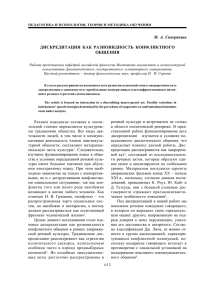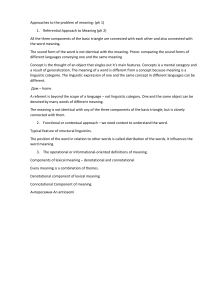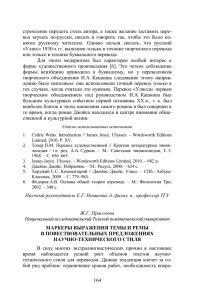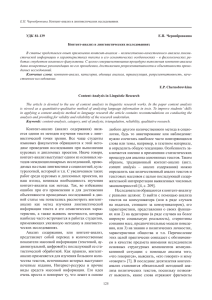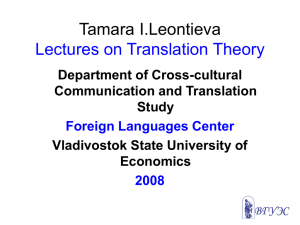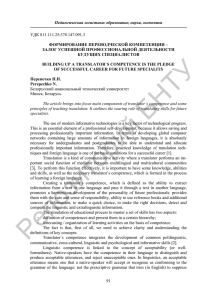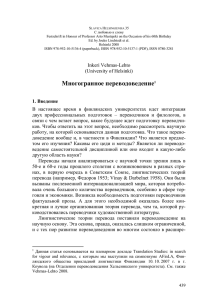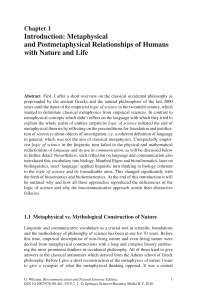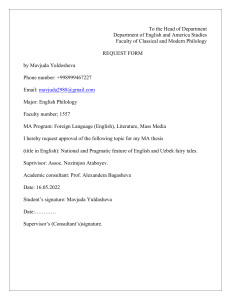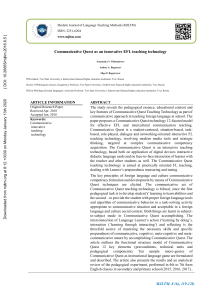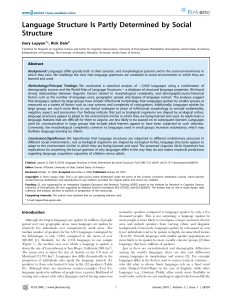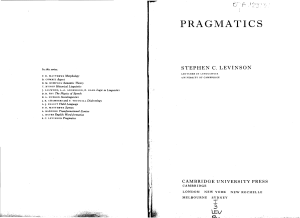PRAGMATICS OF TRANSLATION
реклама
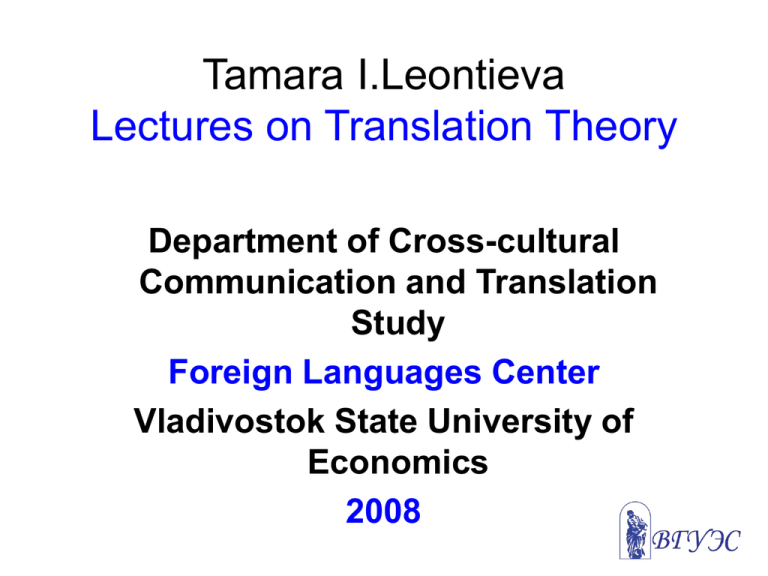
Tamara I.Leontieva Lectures on Translation Theory Department of Cross-cultural Communication and Translation Study Foreign Languages Center Vladivostok State University of Economics 2008 PRAGMATICS OF TRANSLATION General notion and linguistic pragmatics What is pragmatics? Pragmatics, n (used with a singular verb) The noun “pragmatics” is regarded from different sides, the simplest of which is “practical considerations” [1935-40] Webster’s Encyclopedic Unabridged Dictionary of the English Language, 1996. - P.1518. PRAGMATICS Logic, Philos. The branch of semiotics dealing with causal and other relations between words, expressions, or symbols and their users. PRAGMATICS Ling. The analysis of language in terms of (a) situational context within which utterances are made, including (b) the knowledge and beliefs of the speaker and the (c) attitude between speaker and listener. Linguistic Pragmatics SEMIOTICS semantics pragmatics syntax Authors of Linguistic Pragmatics • Charles Morris (US) - introduced pragmatics as part of semiotics • Charles Peirce (US) formulated linguistic pragmatics under the influence of John Austin’s (Great Britain) theory of speech acts (in the 60-ies and 70-ies of the XX century) The Phenomenon of Linguistic Pragmatics Speaker Addressee Linguistic Pragmatics Situation Interaction Linguistic Pragmatics Terminology • Illocution (the speaker’s communicative intention: question, order, information, etc.) • Presupposition (the speaker’s background knowledge of the addressee’s interests, opinions, scope of information) • Locution - the utterance sense (request, promise, information, order, etc.) • Perlocution - the communicative effect of the utterance on the addressee Pragmatics studies co-operative principle of communication Four maxims of successful communication: • • • • quality (Do not make false statements); quantity (Do not say more than required); relevance (Speak to the point); manner (Avoid ambiguity). Speech acts vs speech events • Speech acts are actions performed via utterances (apology, complaint, request, compliment, order, promise, etc.). • A speech event is an activity in which the participants interact in order to arrive at some desired outcome.Usually a speech event consists of a number of utterances moving towards the goal. Classification of speech acts • Declarations: I pronounce you husband and wife. • Representatives: The sky was dark. • Expressives: Fine! Thanks! • Directives: Do it immediately! • Commissives: See you tomorrow. Communicative vs semantic translation Beware of the dog! Осторожно, злая собака! Опасайтесь собаки! Communicative or semantic? Она впервые назвала его на ты. It was for the first time she addressed him in the second person singular. It was for the first time she called him by his Christian name. Conclusions for the Translator • In an adequate translation the communicative effect is close to that of the source text. • At best the text’s communicative effect coincides with the author’s communicative intention. • Two types of translation are caused by the above principle: communicative translation and semantic translation. Even for a Tory polititian he set up a new record for the gap between promise and performance. Даже для деятеля партии Тори это было неслыханное несоответствие (противоречие) между обещаниями и их выполнением. Даже для деятеля партии Тори это было неслыханное несоответствие между словами и делами. В белом плаще с кровавым подбоем, шаркающей кавалерийской походкой, ранним утром четырнадцатого числа весеннего месяца нисана в крытую колоннаду между двумя крыльями дворца Ирода Великого вышел прокуратор Иудеи Понтий Пилат (М.А.Булгаков. Мастер и Маргарита). Early in the morning on the fourteenth of the spring month of Nisan the procurator of Judea, Pontius Pilate, in a white cloak lined with blood-red, emerged with his shuffling cavalryman’s walk into the arcade connecting the two wings of the palace of Herod the Great (Michael Glenny). Early in the morning on the fourteenth day of the spring month of Nisan, wearing a white cloak with a blood-red lining and shuffling with his cavalry’s man gait into the roofed colonnade that connected the two wings of the palace of Herod the Great, walked the procurator of Judea, PontiusPilate (Diana Burgin). LITERATURE 1. Прошина З.Г. Теория перевода с английского на русский и с русского на английский. - Владивосток: Изд-во ДВГУ, 2002. - С.160-169. 2. Лингвистический энциклопедический словарь / Под ред. В.Н.Ярцевой. - М.: Сов. энц., 1990. - С.389-390. 3. Мильруд Р.П. Введение в лингвистику. М.: ДРОФА, 2005. - С.24-28.
